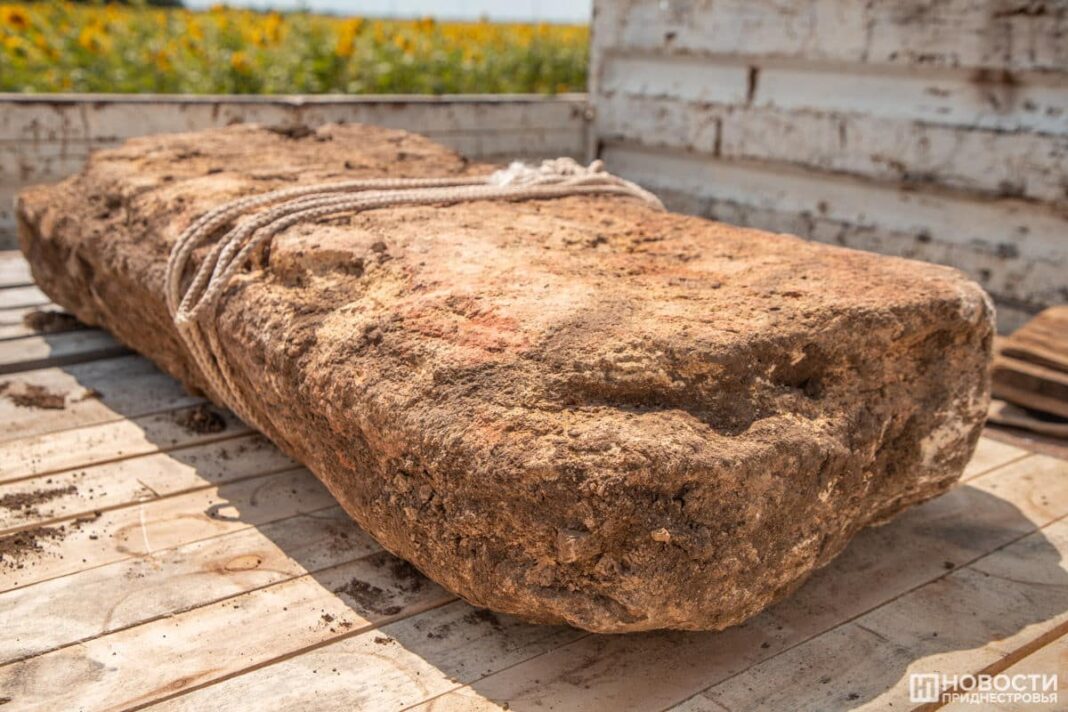Archaeologists of the Pridnestrovian State University discovered the oldest stone sculpture in the Northern Black Sea region in the Slobodzeya region.
According to preliminary data, it is from 4.5 to 5 thousand years old. In other words, it is about 500 years older than the Egyptian pyramids.
As the leading researcher of the research laboratory “Archaeology” of the Pridnestrovian State University, Candidate of Historical Sciences Sergey Razumov, told reporters, the statue is an anthropomorphic stele, that is, a stone slab on which a rough image of a person is applied. At the same time, an image is carved on one side of the slab, and an ocher pattern is applied on the other – obtained from burnt clay with a high content of iron oxides, mixed with vegetable or animal fat. According to Sergei Razumov, such slabs usually depicted facial features, a belt, feet, weapons, signs of power.
The image has been preserved for so many years, thanks to the fact that this slab was laid face down on the burial, over which the barrow was then poured.
The burial belongs to the so-called pit cultural-historical community. A common feature of this community, which spread over the territory from the Danube to the Urals, is the burial of the dead in rectangular pits. Indo-European cattle breeders belonged to it, semi-nomadic tribes who moved across the steppe, lived in wooden carts, although they also knew agriculture.
Over time, this mound turned into a small cemetery, which was used for about 2 thousand years. The last discovered burial in it dates back to the Cimmerian time, that is, 2700-2300 years ago.
As noted by the head of the laboratory, Doctor of Historical Sciences Vitaly Sinika, over the past decades, the mound has been completely plowed up and almost leveled with the surrounding surface. To find it, we had to analyze data from old maps, aerial photography and satellite images.
A total of 7 burials were found in the barrow. The first of them, which refers to the period 2900-2700 years ago, was located directly under the arable land. Vitaly Sinika did not rule out that in the course of further work it would be possible to find two to five more burials.
As for the oldest of the found graves, the one that was covered by the slab found, it belongs to the early Bronze Age. Unfortunately, the remains buried in this grave were poorly preserved. Over time, the boards on which the slab was laid rotted, the stone collapsed into the grave and crushed the bones. Therefore, anthropologists who will analyze the finds will face significant difficulties. It is possible that they will not even be able to establish who was buried in the grave – a man or a woman, and this information will have to be obtained on the basis of DNA studies.
Be that as it may, Vitaly Sinika emphasized that the remains found under the slab are unlikely to belong to an ordinary person. There are no deposits of such a stone nearby, the slab for the statue had to be delivered from afar, and then also processed.
“Most often, in burials covered with such steles, there is nothing but human bones,” the archaeologist explained. – Because the significance of this stele exceeded everything possible that could be put in this grave. Very rarely, as my colleague who studies this period says, they have gold and silver temple decorations – such spirals of wire. So far, we have not had this, but according to the materials of past excavations, this has happened. ”
The finds found in the excavated burial mound will be the subject of study by anthropologists and other specialists. Thanks to this work, in six months or a year, a certain amount of unique information will be obtained in a variety of scientific areas.
As for the found stele, as Vitaliy Sinika emphasized, it is capable of becoming an adornment of the museum collection.
Source: newsstipmr.com









